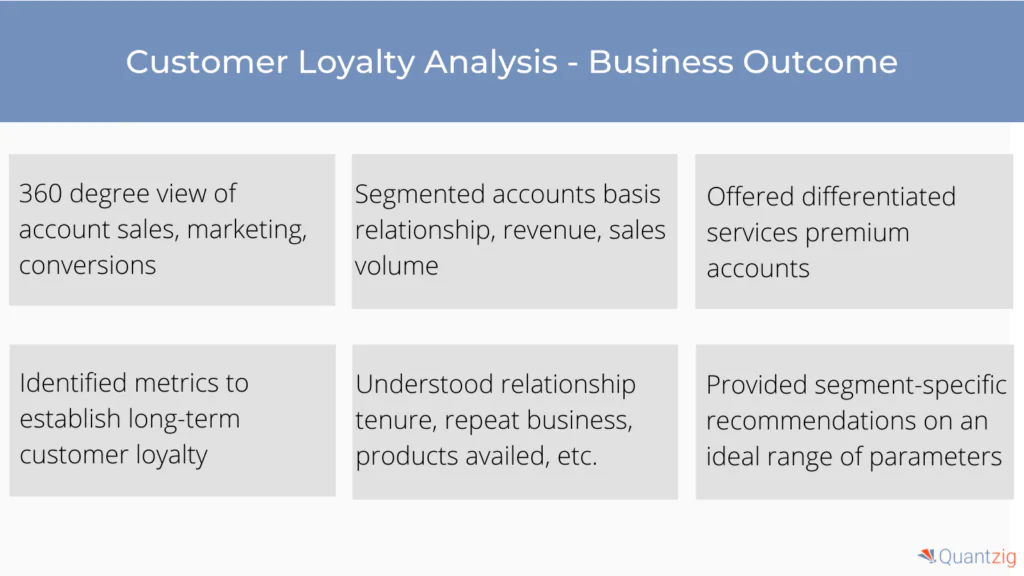Delivering an exceptional experience is crucial for fostering long-term customer loyalty. Understanding your customers deeply is essential for creating such experiences, and this is where Quantzig’s customer loyalty analytics can make a difference. By leveraging big data, Quantzig helps you gain insights into your customers’ preferences and behaviors, allowing you to tailor experiences that meet their expectations. Additionally, Quantzig’s analytics support the development of customer-centric marketing strategies that enhance return on investment.
Book a demo to experience the meaningful insights we derive from data through our ai capacity planning analytical tools and platform capabilities.
Request a Free DemoTable of Contents
How Quantzig Incorporates Customer Loyalty Analytics for Businesses
Customer loyalty analytics aim to uncover the reasons behind customer allegiance to a brand. By analyzing data from various sources, businesses can gain insights into loyalty behaviors and improve their strategies. Key questions to guide data collection include:
- Do customers repeatedly purchase from the same brand?
- Are customers exploring and buying other products or services from the brand?
- Are there alternative brands available to customers?
- How do customers respond to errors or issues, and what common errors do they encounter?
- Are customers leaving positive reviews, and what are they saying?
- What are the areas for improvement if negative feedback is present?
Data for these insights can be derived from multiple channels, including quantitative metrics like customer retention rates and qualitative inputs from surveys and reviews. While these sources are valuable, they may also present some biases. Therefore, businesses should focus on data specifically related to loyalty analytics. Quantzig utilizes a range of sources such as retention rates, surveys, online reviews, social media feedback, customer segmentation data, and engagement metrics to provide comprehensive customer loyalty insights.
Key Takeaways
- Tailored, customer-centric marketing strategies developed through Quantzig’s insights enhance ROI, helping businesses allocate resources effectively.
- Quantzig’s tools like NPS, CLV, and CES measure satisfaction, retention, and engagement to drive sustainable growth.
- Integrating data from multiple sources creates a 360-degree view of customer behavior; essential for understanding needs and improving segmentation strategies.
- Quantzig’s customer loyalty analytics provides valuable insights into customer preferences, allowing businesses to tailor experiences that foster stronger, long-term relationships.
Enhancing Telecom Customer Loyalty: Strategic Insights and Success Stories
| Particulars | Description |
| Client | A Europe-based pharmaceutical company |
| Business Challenge | Improve customer loyalty and maintain a long-term client relationship |
| Solution Impact | Identified metrics most important for establishing long-term loyalty; created loyalty segments to better market offerings to customers |
About the Client
The client, a prominent pharmaceutical manufacturer based in Europe, stands as a leading player in the industry. With a rich portfolio of pharmaceutical products, the client sought to strengthen its market position by enhancing customer loyalty and establishing enduring relationships with pharmacies and hospitals. The evolving pharmaceutical landscape, marked by rising costs and the emergence of local competitors, presented challenges in maintaining market share. Limited orientation in marketing, sales, and after-sales channels further hindered the client’s understanding of individual account needs. The disjointed view of data across various touchpoints compounded these challenges.
The Business Challenge
The client wanted to maintain a long-term customer relationship with the pharmacies and hospitals that they were selling to. Also, the rising costs and increased complexity of the pharmaceutical network combined with the emergence of local players had put the client under enormous pressure to maintain their existing market share. Limited orientation of marketing, sales, and after-sales channels resulted in the lack of understanding of products and services required by each account. Moreover, due to multiple information systems capturing information about their marketing, sales, and client data, the organization had a splintered view of their customers across different contact points.
After hearing about Quantzig from another industry veteran, the client decided to connect with our experts to understand what they can achieve with us.
To address the clients’ requirements and enhance loyalty, the client needed a holistic data management and analytics solution to integrate the data spread across multiple soiled systems and analyze it to achieve the following objectives:
- 360-degree view of the accounts, account structure, and decision-makers
- Value of customer segments
- Offer account-specific products and services
- Achieve better loyalty and centricity
The Solution
To understand customer preferences and enhance sales, Quantzig experts implemented a comprehensive customer loyalty analysis, starting with finalizing business scope and integrating multi-source data (account, channel, product) into a single analyzable set. Data cleansing and business rules were applied before developing clustering and multivariate regression models. This enabled the analysis of sales performance and bid-winning probabilities, while self-generating decision boards in Tableau provided insights into customer segments, price sensitivity, and marketing response.

Quantzig’s customer loyalty analysis delivered a 360-degree view of account, sales, and marketing data. Accounts were segmented into Bronze, Silver, Gold, and Platinum based on relationship length, revenue, and sales volume, enabling tailored services for top-tier clients. Multivariate regression identified metrics critical to long-term relationships, while price elasticity models provided recommendations to optimize sales volume and profit margins.
Key insights included real-time price adjustment capabilities, variables affecting deal wins/losses, and a Deal/Win-loss simulator to improve pipeline velocity. Quantzig’s data analytics solutions empowered the client to optimize sales activities and maximize the probability of success in real-time.
Implement our solutions to solve your complex business challenges at no cost with our 4-week free pilot. This offer bears no hidden clauses and serves as a perfect opportunity to explore our comprehensive portfolio of advanced BI and business analytics solutions.
Request a free pilotPharmaceutical Industry Overview
The global pharma industry is witnessing immense growth due to the presence of numerous competitors who are involved in the production, development, and marketing of medications. With the majority of revenues coming from the United States and Europe, the pharma industry is witnessing a high demand for pharmaceuticals such as pain drugs, antihypertensives, and antidiabetics. In the pharma industry, the growing demand among the target audience is further triggering the need for research and development in the segment. Although the pharma industry is witnessing relentless demand among the end-user segments, certain factors are responsible for the hindrance of the market’s growth. These factors include:
- Rising client expectations: In recent years, with the shift toward a consumption-driven economy, countries across the globe are imposing cost constraints on healthcare service providers. Moreover, with the customers becoming more informed than ever before, they are looking for clinically and economically better alternatives as compared to the existing alternatives.
- Policy reforms: Today, any changes in the healthcare regulations significantly affects the pharma industry. Leading policy reforms are in place to ensure the quality, safety, and efficacy of therapeutic drugs to target audiences. Moreover, overseas manufacturers are expected to operate to the general standards to meet the licensing requirements of the specific region.
To address such issues and meet the relentless demands of the target audience in the pharma industry, leading organizations are utilizing customer loyalty analysis. Customer loyalty analysis ensures better visibility into the client’s tastes and preferences and offers better satisfaction to the customers.
Use Quantzig to Analyze Customer Loyalty and Drive Growth
In a competitive market, customer loyalty is crucial for long-term business growth, especially in the B2B sector. Quantzig offers innovative analytics solutions that empower businesses to enhance marketing strategies and foster lasting relationships.
Key offerings include:
- Net Promoter Score (NPS): Measures client satisfaction and loyalty.
- Repeat Purchase Rate (RPR) & Customer Retention Rate (CRR): Provide insights into repeat business and retention.
- Customer Lifetime Value (CLV) & Customer Satisfaction Score (CSAT): Help businesses understand customer value and satisfaction levels.
- Big Data & Qualitative Insights: Analyze data from surveys, reviews, and social media for a holistic view of customer behavior.
- Customer Effort Score (CES) & Segmentation: Offer advanced customer journey analysis.
By leveraging these tools, Quantzig enables businesses to improve customer engagement, enhance brand perception, and drive sustainable growth. Trust Quantzig for data-driven solutions that propel your business forward.




